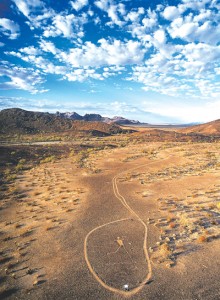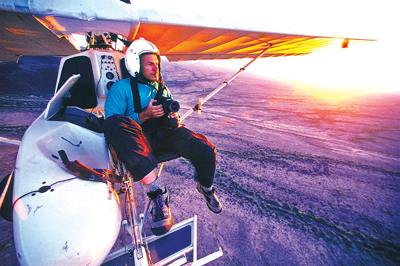By Greg Brown

Aerial photographer Adriel Heisey shoots scenic landscapes from his custom-built Kolb TwinStar ultralight aircraft.
We aviators know how privileged is our view from above; we thrill to Earth’s vigor, form and splendor on every flight. Yet few of us have the skills to capture that magic and convey it to others. I was reminded of that when the announcement arrived for Adriel Heisey’s new exhibit, “From Above: Images of a Storied Land.” You’ve likely seen Heisey’s spectacular aerial photography on public television specials, and in magazines like National Geographic, Arizona Highways and Smithsonian.
I first got to know Adriel when writing my book, “Flying Carpet: The Soul of an Airplane.” Graciously, he loaned a photo of Miss Navajo Nation in full traditional dress—circling Arizona’s mystical Window Rock in an ultralight aircraft. But although we shared enjoyable phone conversations, I’d never met the photographer in person.
At that time the show was premiering at the Albuquerque Museum, so when the invitation arrived, I wrote Heisey asking whether the long journey from Phoenix was justified to meet him.
“Yes!” he replied. “This is the biggest show of my career; it’s traveling all over the country. You’re invited to a private preview and reception on Saturday.”
My wife Jean consented to join me, and two days later, we were aloft. On maps, the flight from Phoenix to Albuquerque might seem a drab two-hour trek, but from the sky it’s enthralling—Lake Roosevelt shimmering before the daunting Sierra Ancha, ski slopes on snow- and pine-frosted Mt. Baldy, smooth-shaven volcanic cinder cones offering soft green craters skyward, and miles-wide malpais lava flows bubbling as if they had hardened just yesterday. Crowning the trip is Old Acoma Pueblo, its thousand-year bloodline etched in adobe atop a remote golden mesa. Even three bounces on landing at Albuquerque couldn’t dull the afterglow of such a journey.
“What an amazing flight,” said Jean, tying down the airplane at Double Eagle Airport. “No one on the ground could possibly imagine what we’ve just seen.”
It was true; how could mere art match such sights? But then we entered Heisey’s gallery. From altitudes of just 20, 50, or 100 feet, the artist had modeled people, Earth, and history in the warm light and dark shadows of dawn and dusk.
Most incredible, however, was realizing that we’d just lived the stuff of which Adriel’s photographs are made, if only we could linger long enough, low enough, and at precisely the right moments to capture flight’s passing treasures. For Heisey’s exhibit celebrated the very red-rock landscape we had just tasted by Flying Carpet.
Heisey himself soon appeared before the show’s central feature, a Kolb TwinStar ultralight aircraft suspended before a colossal photomural. On a nearby video monitor, the ultralight’s shadow fluttered across ageless rock with the fragility of a sparrow.
“Is that you, Greg?” asked Heisey, turning toward me. “And Jean! I’ve read about you in Greg’s stories.”
Beginning his talk, the artist told of starting flight training in Pennsylvania in 1978.
“My girlfriend asked me to join her for a semester, student teaching on the Navajo Reservation,” he said. “I accepted the invitation, and was immediately captivated by the landscape and Native culture of the “Four Corners” region of Arizona, New Mexico, Colorado and Utah. It changed my life.”
Vowing to return, he completed flight training in Pennsylvania and flew the East for five years.
“Finally, I realized that I’d only get out West by setting a date,” he recalled. “So I gave notice and moved back to the Four Corners without a job.”
After a stint piloting single-engine Cessnas on medical missions, Adriel joined the Navajo Tribal Government flight department in Window Rock, Ariz. That allowed him to hike remote reaches of the Four Corners area while living and flying in the heart of it.
“Life here isn’t for everyone,” he admits. “You must adjust to remote living and being a minority in what’s basically a third-world sovereign nation. But for me it was perfect.”
On empty flight legs, Adriel delighted in photographing Southwest landscapes from the air. But the tribe sold its last single-engine plane in 1990, and aerial photography wasn’t feasible from the remaining King Air turboprops. So on days off, Heisey built the TwinStar ultralight. To accommodate low-level photography, he replaced one seat with a camera storage compartment, and improvised a control strap for flying with one leg while shooting handheld photos, changing film, and swapping lenses.
“I’ve yet to drop anything,” he answered to everyone’s unasked question.
“Flying at altitudes of 30 to 600 feet, my pusher prop and open air perch allow shooting from straight and level flight, unlike in conventional aircraft where the need for uncoordinated slips and skids makes low-altitude photography dangerous,” he explained.
His TwinStar features a ballistic parachute in case of engine failure.
“Even at 35 mph, I fly in remote places where landing an open vehicle with no frontal protection could be deadly,” he said.
So far, the more real threat has been from people. While photographing archeological sites near Phoenix last year, he was intercepted by a law enforcement helicopter and interrogated by the FBI.
“I guess the ancients didn’t anticipate the nearby nuclear power plant when locating their constructions,” he observed.

The Fisherman Intaglio, a prehistoric earth figure, is located in the foothills of Arizona’s Plomosa Mountains east of the Colorado River.
Next came Heisey’s photographs, capturing the ethereal nature of time—prehistoric ruins perched precariously atop rock pinnacles, timeless but ephemeral images of everyday life plucked from above the Navajo Nation Fair, and the aerial geometry of a highway interchange for the wonderment of tomorrow’s archaeologists. All seemed transitory in their Southwest setting of seemingly eternal rock. Yet even stone crumbles, noted Heisey reverently of a monumental spire.
“This column has fallen since I took the photograph,” he said.
For the reception, we reconvened at an Old Town Albuquerque law office housing the largest private collection of Adriel’s prints. There we met the archeologist who first inspired the photographer’s work, and a tribal council member from one of Heisey’s subjects, Acoma Pueblo, over which we’d flown that very morning. Adding spice to the affair was only-in-New-Mexico cuisine: chicken skewers with molé sauce, red chile lamb on fry bread, and salmon mousse canapés on cucumber with fruit salsa.
It seems ironic that a museum exhibit should enhance the view from our Flying Carpet. But much as we’d enjoyed the morning’s flight to Albuquerque, our trip home that evening was imbued with new appreciation of the landscape beneath us. With each new perspective we imagined Heisey flitting below in his ultralight, a monocular eagle sculpting spires and promontories in the orange stage lights of sunset.
“We can’t fly at 20 or 50 feet like Adriel does,” observed Jean, “but all the details are still there. We just need to look for them.”
What inspired Adriel Heisey to build an ultralight and set forth on such daring photo expeditions? I doubt that even he could answer, but look to his example to explain why flying is often justified even on seemingly impractical journeys, for no grander reason than that the urge has struck. We pilots owe it to ourselves to follow our whims to the horizon, seeking distant treasure wherever it might exist.
For Jean and me, this impulsive mission to Albuquerque delivered gold of the highest purity—that of sunrise striking ancient ruins from the vantage of a kindred spirit in flight. Adriel Heisey sees what we all see from the air, only better. In homage to his photos, all I can say is, “No wonder we fly!”
Adriel Heisey’s exhibit, “From Above: Images of a Storied Land,” currently appears at the University of Pennsylvania Museum of Archaeology and Anthropology in Philadelphia, from July 16 through October 2. (For exhibit information, see [http://www.museum.upenn.edu]. Visit the photographer’s website at [http://www.adrielheisey.com].)
Author of numerous books and articles, Greg Brown is a columnist for AOPA Flight Training magazine. Portions of this column also appeared in AOPA Pilot. Read more of his tales in “Flying Carpet: The Soul of an Airplane,” available through your favorite bookstore, pilot shop, or online catalog, and visit [http://www.gregbrownflyingcarpet.com].











